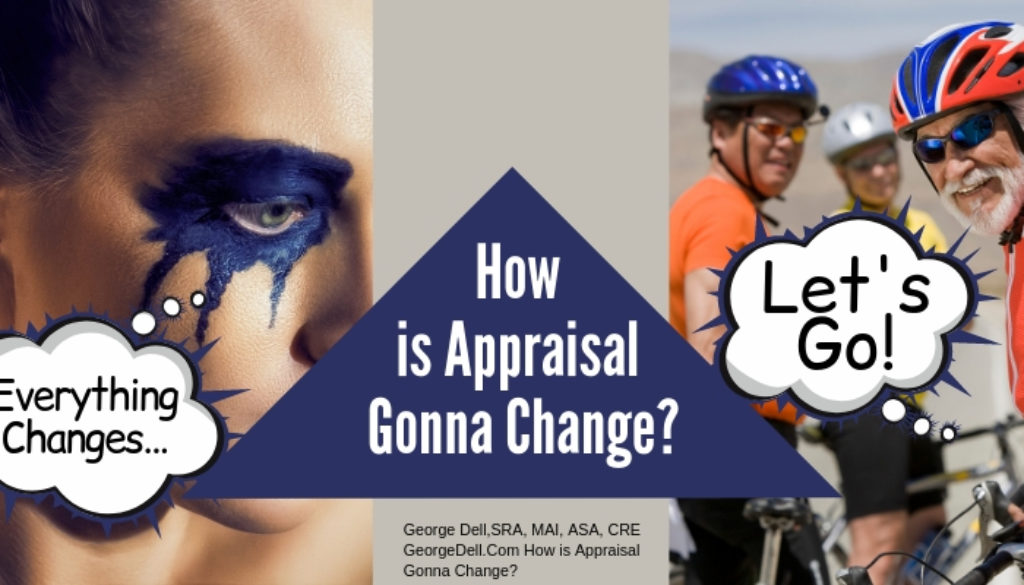And change it does. The biggest changes slip in almost without notice.
USPAP recognizes change. In fact, Standard 1-1 says:
…the principle of change continues to affect the manner in which appraisers perform appraisal services.
It specifically recognizes change in cost, construction, marketing, law, lending all lead, or should lead to
corresponding changes in appraisal theory and practice.
It goes on:
To keep abreast of these changes and developments, the appraisal profession is constantly reviewing and revising appraisal methods and techniques and devising new methods and techniques to meet new circumstances.
In these posts, we often talk about changes in data and changes in the power of analytics. But that’s not all. Real estate itself is attuned to a more homogeneous competitive product, with more distinct elements of comparison. Homes are more similar. Retail more interactive with demographics. And commercial properties of all types are more finely tuned in their competitive features. The optimal use is more distinct. Optimal use is calculable, using better data, and better business intelligence analytics. The old HABU “Highest and Best Use” is less distinct, even as reduced to three parts: legal, possible, and feasible.
For this reason, it’s not sufficient for appraisers to simply maintain the skills and the knowledge they possess when they become appraisers. Each appraiser must continuously improve his or her skills to remain proficient in real property appraisal.
What new “appraisal methods and techniques” have we seen? As I speak to reviewers who see valuations from around the country, there seems to be a degradation of quality. Less analysis rather than more. Less explanation rather than clearer logic. More “trust me” and less “see my reasoning.”
What does the world really need? Trust my opinion—or see the result? Trust my comps—or see market parameters.
Competitors for valuation, risk, and investment needs want “better, faster, cheaper.” For now, lets just look at “better.” What is “better?”
“Better” is actually fairly simple. There are only three parts: 1) is the right question being asked; 2) is the result true (accurate); and 3) how sure (precise) is the result? So, let’s look briefly at each of these needs, and how each can be helped with today’s technology.
- Appropriateness: the right question is the right market segment, and the right predictors (“elements of comparison”). Modern data science and econometric theory simplify this. Several tools are available to identify when there are “missing” predictors, telling the analyst-appraiser to look deeper. The data guides the subject-matter expert—the appraiser.
- Trueness (accuracy/unbiasedness) is the result of identifying the right market (from #1 above), but also using the right information. This is a process of classification. Traditionally, this means “is it a comp, or not a comp?” In today’s data science paradigm, this means “is it part of the CMS (Competitive Market Segment)”© or not. In data science this is a problem of classification. There are several computative/econometric tools available for categorizing data. Classification is one of the two core tools of today’s valuation practice, using today’s analytics.
- Sureness (precision/exactness) is the result of using the right amount of information. If you use too little data (few comps), you lose sureness. Your result will cluster around the true answer, but there is little reliability (aside from issues of data or appraiser bias). If you use too much data, your trueness does not improve, but sureness goes down (variability goes up). Some call this ‘garbage’ data. It should not be used. This is all measured by a measurable appropriateness. (ASA literature calls it “appositeness”).
Appraisers and our professional organizations must adapt to this change. Opinions are less important. Analytical results are more important. We must begin to do what we were taught in the third grade: “Show your work.”
The teacher said “I don’t care how strong you believe in your answer.” “I want to see your work!”
We must move from credibility/believability to reproducibility/reliability. Change.
